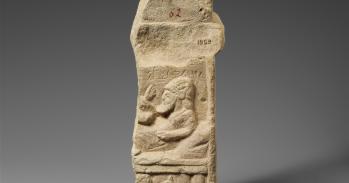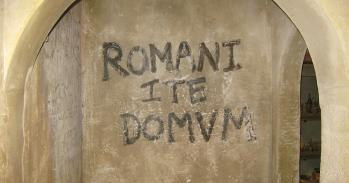
A new data crowdsourcing platform aims to preserve the sound of Romeyka, an endangered millennia-old variety of Greek. Experts consider the language to be a linguistic goldmine and a living bridge to the ancient world.
A new data crowdsourcing platform aims to preserve the sound of Romeyka, an endangered millennia-old variety of Greek. Experts consider the language to be a linguistic goldmine and a living bridge to the ancient world.
Raising the status of minority and heritage languages is crucial to social cohesion, not just in this region, but all over the world
Professor Ioanna Sitaridou
The initiative, led by Professor Ioanna Sitaridou (Queens' College and Faculty of Modern and Medieval Languages and Linguistics), contributes to the UN’s International Decade of Indigenous Languages (2022-32), which aims ‘to draw global attention on the critical situation of many indigenous languages and to mobilise stakeholders and resources for their preservation, revitalization and promotion.’
Romeyka is thought to have only a couple of thousand native speakers left in Turkey’s Trabzon region, but the precise number is hard to calculate especially because of the fact that there are also a large number of heritage speakers in the diaspora and the ongoing language shift to Turkish.
Romeyka does not have a writing system and has been transmitted only orally. Extensive contact with Turkish, the absence of support mechanisms to facilitate intergenerational transmission, socio-cultural stigma, and migration have all taken their toll on Romeyka. A high proportion of native speakers in Trabzon are over 65 years of age and fewer young people are learning the language.
The newly launched trilingual Crowdsourcing Romeyka platform invites members of the public from anywhere in the world to upload audio recordings of Romeyka being spoken.
“Speech crowdsourcing is a new tool which helps speakers build a repository of spoken data for their endangered languages while allowing researchers to document these languages, but also motivating speakers to appreciate their own linguistic heritage. At the same time, by creating a permanent monument of their language, it can help speakers achieve acknowledgement of their identity from people outside of their speech community,” said Professor Sitaridou, who has been studying Romeyka for the last 16 years.
The innovative tool is designed by a Harvard undergraduate in Computer Science, Mr Matthew Nazari, himself a heritage speaker of Aramaic. Together they hope that this new tool will also pave the way for the production of language materials in a naturalistic learning environment away from the classroom, but based instead around everyday use, orality, and community.
To coincide with the platform’s launch, Sitaridou is unveiling major new findings about the language’s development and grammar at an exhibition in Greece (details below).
Sitaridou’s most important findings include the conclusion that Romeyka descends from Hellenistic Greek not Medieval Greek, making it distinct from other Modern Greek dialects. “Romeyka is a sister, rather than a daughter, of Modern Greek,” said Sitaridou, Professor of Spanish and Historical Linguistics. “Essentially this analysis unsettles the claim that Modern Greek is an isolate language”.
Over the last 150 years, only four fieldworkers have collected data on Romeyka in Trabzon. By engaging with local communities, particularly female speakers, Sitaridou has amassed the largest collection of audio and video data in existence collected monolingually and amounting to more than 29GB of ethically sourced data, and has authored 21 peer-reviewed publications. A YouTube film about Sitaridou’s fieldwork has received 723,000 views to-date.
Grammar and a new phylogeny for Greek
Sitaridou’s analysis of the Romeyka infinitive is key. All other Greek dialects known today have stopped using the infinitive found in ancient Greek. So speakers of Modern Greek would say I want that I go instead of I want to go. But, in Romeyka, the infinitive lives on and Sitaridou has observed uncontroversial proof that this Ancient Greek infinitive can be dated back to Hellenistic Greek due to its preservation in a structure which became obsolete by early Mediaeval times in all other Greek varieties, but continued to be used in Romeyka while also undergoing a cross-linguistically rare mutation to a negative item.
Sitaridou’s findings have significant implications for our understanding of the evolution of Greek, because they suggest that there is more than one Greek language on a par with the Romance languages (which all derived out of Vulgar Latin rather than out of each other).
Historical context and new field work sites
The roots of the Greek presence in the Black Sea are steeped in myth: from the journey of Jason and the Argonauts to Colchis, to the Amazons. But what we know is that the Greeks began to spread around the Black Sea from approximately the 6th Century BCE. Ionians founded Miletus, which, in turn, founded Sinope, which, eventually, colonized Trebizond. In the Pontus, the language of the first Greek colonizers of Trebizond was the Ionic Greek of Sinope.
In the 4th Century BCE, the passage of Alexander the Great’s army contributed to the creation of another Greek-speaking centre, to the South of Pontus, at Cappadocia. It is possible that from Cappadocia, Greek may have also spread northwards towards Pontus.
However, the decisive phase for the expansion of the Greek language seems to be Christianization. The inhabitants of Pontus were among the first converts and are mentioned in the New Testament. The Soumela monastery was founded in 386 CE, around 20 years after the region officially adopted Christianity. The fall of Trebizond to the Ottomans in 1461 led to the city becoming majority Muslim.
Professor Sitaridou said: “Conversion to Islam across Asia Minor was usually accompanied by a linguistic shift to Turkish, but communities in the valleys retained Romeyka. And because of Islamisation, they retained some archaic features while the Greek-speaking communities who remained Christian grew closer to Modern Greek, especially because of extensive schooling in Greek in the 19th and early 20th centuries.”
Recently, Professor Sitaridou started field working in a new site, Tonya, where no other field worker has ever reached, only to reveal significant grammatical variation between the valleys indicating different Islamisation onset. In a publication to appear soon, it is argued that both the syntax of subordination and negation systems in Tonya show different patterns and thus diachronic development from the Çaykara variety.
In 1923, under the Greco-Turkish population exchange, Greek-speaking Christians of Pontus were forced to leave Turkey and relocate to Greece while Romeyka-speaking Muslim communities in the Trabzon area remained in their homeland as they professed Islam, explaining why this Greek variety is still spoken in small enclaves in the region. Since 1923 and until very recently the two speech communities were oblivious of each other’s existence.
Preservation of heritage languages and why it matters
Speakers are still reluctant to identify Romeyka as one of their languages since, for Turkish nationalists, speaking Greek goes against the very fundamentals of one’s belonging. From a Greek nationalist perspective, these varieties are deemed ‘contaminated’ and/or disruptive to the ideology of one single Greek language spoken uninterruptedly since antiquity, as Sitaridou explains in an article which is about to be published by the Laz Institute in Istanbul.
In Greece, Turkey and beyond, Sitaridou has used her research to raise awareness of Romeyka, stimulate language preservation efforts and enhance attitudes. In Greece, for instance, Sitaridou co-introduced a pioneering new course on Pontic Greek at the Democritus University of Thrace since the number of speakers of Pontic Greek is also dwindling.
“Raising the status of minority and heritage languages is crucial to social cohesion, not just in this region, but all over the world,” Professor Sitaridou said. “When speakers can speak their home languages they feel 'seen' and thus they feel more connected to the rest of the society; on the other hand, not speaking the heritage or minority languages creates some form of trauma which in fact undermines the integration which linguistic assimilation takes pride in achieving”.
The same ethos traverses a new AHRC-funded project about the documentation of a critically endangered language, Sri Lanka Portuguese, among Afrodescent communities in north-western Sri Lanka. Sitaridou will be documenting and analysing manja, the only remaining linguistic and cultural expression of African heritage for these communities.
A Romeyka speaker's view
It is rare for Romeyka speakers to discuss their language publicly. Reflecting on her interactions with Professor Sitaridou, one such speaker, Mrs Havva Sarı, said:
“For me, it is very sad that the Romeyka language is lost, and it is also sad that young people do not speak it. We can only express ourselves with this language. Our jokes, our cries, and our folk songs are all in the Romeyka language. I raised my children in this language because I did not have another language. I would love for them to teach this language to their children, but everyone goes to the cities. They settled down and married people from different cultures. My children's children cannot speak the Romeyka language anymore, which makes me very sad.”
“I was very happy that there was someone from a different country who showed interest in the Romeyka language. It means that our language is very valuable. Ioanna, who did this research, communicated with me in the same language. I love her like a daughter.”
Exhibition at Mohamed Ali’s historical House in Kavala
The Romeyka exhibition runs at the MOHA Research Centre in Kavala, Greece, from 29 March to 28 April 2024.
The exhibition features previously unpublished archival material from Exeter College, Oxford and photographic material from British School of Athens which give us a glimpse into the Greek-speaking communities and language in the southern Black Sea shores 110 years ago taken by R M Dawkins, one of the first field workers in the area. This is combined with photographs and video material from Professor Sitaridou’s own fieldwork, interspersed with panels and audio material to communicate her linguistic findings.
The exhibition aims to generate further reflections on endangered heritages, fragmented and shared identities and collective memory as well as helping us get a better grasp of multilingualism, localised experiences, intergenerational stories of co-existence and displacement, diasporic selves and language loss, and alternative modalities of being and belonging both in Greece and Turkey.

The text in this work is licensed under a Creative Commons Attribution-NonCommercial-ShareAlike 4.0 International License. Images, including our videos, are Copyright ©University of Cambridge and licensors/contributors as identified. All rights reserved. We make our image and video content available in a number of ways – on our main website under its Terms and conditions, and on a range of channels including social media that permit your use and sharing of our content under their respective Terms.




